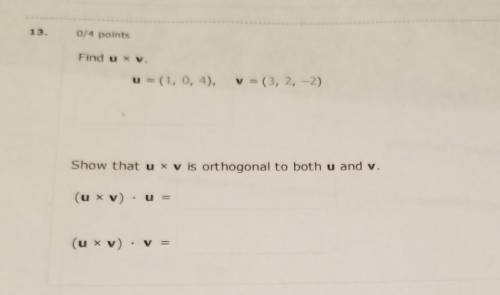13.
0/4 points
Find u xv.
u = (1, 0, 4),
v = (3, 2, -2)
Show that ux v is o...

Physics, 27.04.2020 02:29 Mordred809
13.
0/4 points
Find u xv.
u = (1, 0, 4),
v = (3, 2, -2)
Show that ux v is orthogonal to both u and v.
(ux v) · u =
(u x v)
v =


Answers: 1
Another question on Physics

Physics, 21.06.2019 22:30
Follow these directions and answer the questions. 1. shine a pencil-thin beam of light on a mirror perpendicular to its surface. (if you don't have a laser light as suggested in the video, you can make a narrow beam from a flashlight by making a cone from black construction paper and taping it over the face of the flashlight.) how does the light reflect? how does the relationship of incident to reflected ray relate to the reflection of water waves moving perpendicular to a barrier? 2. shine a pencil-thin beam of light on a mirror standing on a sheet of paper on the table (or floor) so that you can mark the incident ray and reflected ray. (you can support the mirror from the back by taping it to a wooden block.) 3. mark a line on the paper representing the reflective surface. (the reflective surface of a mirror is usually the back edge.) 4. draw a dashed line perpendicular to the mirror surface at a point where the incident and reflected ray meet. this perpendicular is called a normal to the surface. 5. measure the angles between the rays and the normal. the angle of incidence is the angle formed by the incident ray and the normal to the surface. the angle formed by the reflected ray and normal is called the angle of reflection (r). what is the angle of incidence? what is the angle of reflection? 6. repeat for several different angles. (see report sheet for details.) what appears to be the relationship between the angle of incidence and angle of reflection? in science 1204, what was the relationship for these two angles made by the reflection of waves in a ripple tank? 7. roll a ball bearing so that it hits a fixed, hard surface (a metal plate) at several angles (including head-on). observe the way in which the ball bearing reflects. what generalization can you make about how a ball bearing reflects from a wall? have you proved that light can only behave like a wave?
Answers: 1

Physics, 22.06.2019 16:50
Calculate the first and second velocities of the car with four washers attached to the pulley, using the formulas v1 = 0.25 m / t1 , and v2 = 0.25 m / (t2 – t1) where t1 and t2 are the average times the car took to reach the 0.25 and the 0.50 meter marks. record these velocities, to two decimal places, in table e.
Answers: 2

Physics, 22.06.2019 18:00
Air enters a gas turbine with two stages of compression and two stages of expansion at 100 kpa and 17°c. this system uses a regenerator as well as reheating and intercooling – the intercooler returns the air to the inlet temperature. the pressure ratio across each compressor is 4 ; 300 kj/kg of heat are added to the air in each combustion chamber; and the regenerator operates perfectly while increasing the temperature of the cold air by 20°c. determine the system’s thermal efficiency. assume isentropic operations for all compressor and the turbine stages and use constant specific heats at room temperature. (0.378)
Answers: 3

Physics, 22.06.2019 18:30
Both speed and velocity measure how fast something is moving. however, since speed is not a it does not require a(n question 6 options: a) quantity , unit b) magnitude, unit c) scalar, direction d) vector, direction
Answers: 2
You know the right answer?
Questions

History, 16.09.2019 01:30


History, 16.09.2019 01:30

Biology, 16.09.2019 01:30

Computers and Technology, 16.09.2019 01:30




Mathematics, 16.09.2019 01:30

History, 16.09.2019 01:30

Biology, 16.09.2019 01:30

Mathematics, 16.09.2019 01:30


Mathematics, 16.09.2019 01:30





History, 16.09.2019 01:30

Spanish, 16.09.2019 01:30



